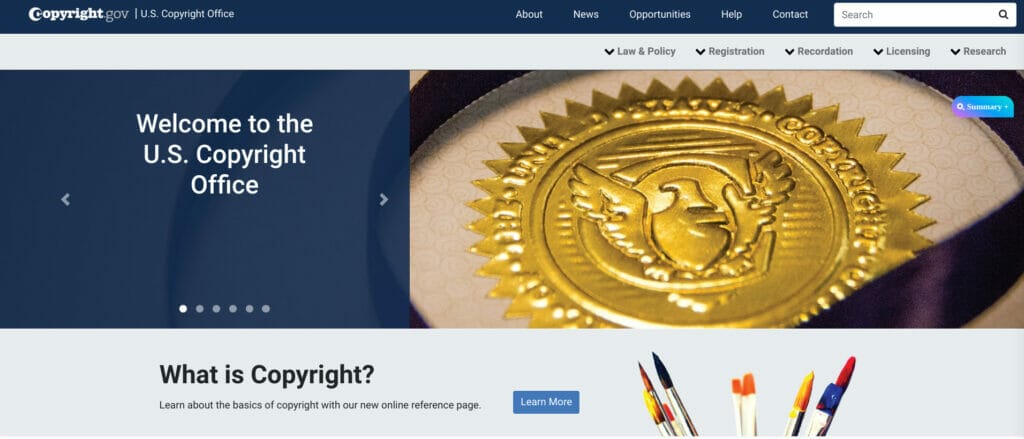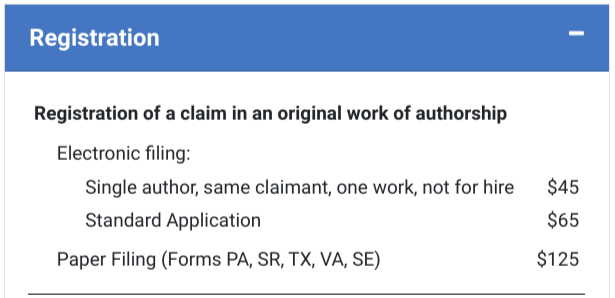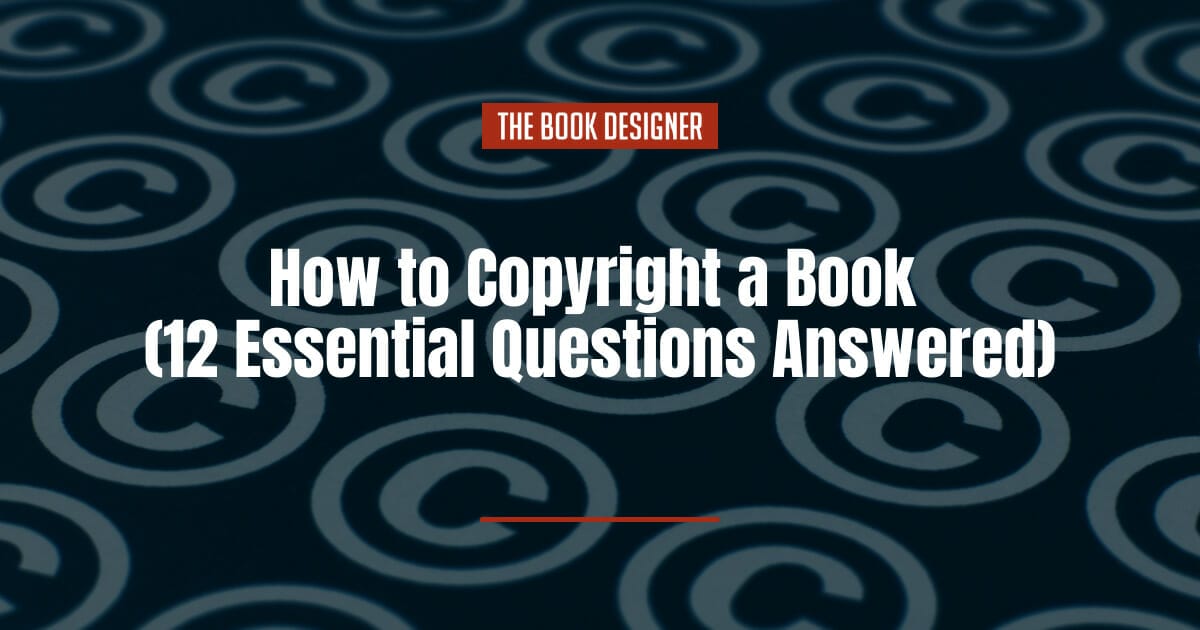One of the most common questions I hear from self-publishers hasn’t changed at all over the years: “How do I copyright a book?”
If you are looking for a quick and easy guide about how to copyright a book, you have come to the right place. In this article, I’ll show you how to choose the right copyright application, fill it out, determine how much it will cost, and exactly how to get your application and book details registered with the copyright office.
Although this process seems daunting, it is surprisingly not as difficult as many authors worry that it will be; however, because you are dealing with the government, it pays to be cautious and do things properly.
Let’s get started!
Table of Contents
Why Get Your Work Copyrighted?
Authors are often understandably concerned about copyright infringement when they have worked so long and hard on their books. The good news is that any work you create is automatically and immediately protected by copyright—make sure you have a copyright page in your book. Of course, it is still beneficial to register your work, as it provides extra legal protection and could offset the cost of any necessary legal fees to protect the registered copyright.
But now, book in hand and still a sparkle in the eye, you are ready to register your copyright. Let’s get started.
Visiting the Copyright Office— Online, That Is
The Copyright Office, a branch of the Library of Congress, is located in the James Madison Memorial Building in Washington, D.C. However, we’re going to their online location at https://www.copyright.gov/.
Here’s what you’ll find when you get there:

How to Copyright a Book – Registration Basics
You will need three elements to complete your registration:
- A completed application,
- A (nonrefundable) filing fee, and
- A (nonreturnable) deposit, which means a copy of your book
Pricing

The first step in registering your copyright is finding out which of these two paths you should take to apply.
Online Registration
This is done through the Electronic Copyright Office (eCO). This is the best, fastest, and least expensive way to register most books, and is the method much preferred by the eCO.
- $35 for a single application, $55 for standard
- Online tracking of the status of your copyright application
- Faster processing time and secure payment
- Option to upload your book electronically or mail it in
Any work that is a compilation of multiple works, was created for hire, or was written by multiple authors (or artists, performers, photographers) will use the standard application. If you are unsure about whether you should use the single or standard application, check out this page.
How to do it: Use this link to go to the electronic Copyright Office and register for an account to get started. You’ll then follow the prompts to register your book.
How long it takes: Most electronically filed applications take up to 9 months to receive their certification, though many will receive theirs earlier.
Registration with Paper Forms
The traditional method for filing copyright. Most written books will use the form TX (for literary works), while photography books and other books made up of visual arts will use the VA form (for visual arts). Once you have downloaded the appropriate form you must print it out, fill it in, sign it, and mail it with at least one copy of your manuscript (which the copyright office calls a ‘deposit’) and a check or money order for the application fee of $85.
How to do it: Find the appropriate form on this page of the Copyright Office’s website
How long it takes: Those who register with paper forms may receive their certifications up to 18 months after they have applied, though some will receive theirs earlier.
Regardless of which method you choose, your copyright registration becomes effective on the date that the copyright office receives the complete submission.
Q and A with the Copyright Office
The Copyright Office offers a FAQ page that answers some of the most common copyrighting questions. I did a brief summary here, but you can find the full list of questions and complete answers on their website here and here.
Are literary works protected?
Yes, as well as other works like musical works, dramatic works, choreographic works, pictorial works, motion pictures, sound recordings, and architectural works.
Do I have to send in my work? Do I get it back?
Yes, the Copyright Office requires a copy of the work for which you are requesting copyright protection. Check here to see if you qualify for electronic submission or if you are required to send a hard copy. Submitted copies will not be returned.
Will my deposit be damaged by security measures in place on Capitol Hill?
Package the items listed in boxes rather than envelopes to avoid damage caused by security measures:
- electronic media such as audio cassettes, video cassettes, CDs, and DVDs
- microform
- photographs
- slick advertisements, color photocopies, and other print items
May I register more than one work on the same application? Where do I list the titles?
Unpublished works can be registered as a collection with one title on a single application when certain conditions are met.
Do I have to use my real name on the form? Can I use a stage name or a pen name?
No, you do not have to use your real name on the application form. There is no legal requirement that the author be identified by his or her real name on the application form.
Will my personal information be available to the public?
Yes. Copyright registrations are public records.
Can I submit my manuscript on a computer disk?
No. Floppy discs, zip disks and other removable media are not allowed. Only CD-ROMS are acceptable. Printed copies and audio recordings of the work are required. Floppy disks and other removable media such as Zip disks, except for CD-ROMs, are not acceptable. For additional information on requirements regarding electronic and hard copy deposits of your work, read Circular 7b, Best Edition of Published Copyrighted Works for the Collection of the Library of Congress, and Circular 7d, Mandatory Deposit of Copies or Phonorecords for the Library of Congress.
Does my work have to be published to be protected?
Publication is not necessary for copyright protection.
How much do I have to change in my own work to make a new claim of copyright?
Substantial changes to a work can receive a new claim of copyright, as long as it’s more than minor changes.
For information on the Copyright Office mailing requirements, process time, application forms, and more, visit their website.
A Final Word on Copyright
Well, there you have it. In practice, this is not a complicated process. Most people will simply log onto the Copyright Office website, create an account, and fill out the online form. It doesn’t take long and it’s not very intimidating. In the interest of being thorough, I like to give you all the options so you can decide which suits you best.
But don’t neglect this important task. Although your book will still be copyrighted, if you don’t send in the forms and the filing fee, your copyright will not be registered. And it’s the registration that will be critical if there’s any dispute about your copyright in the future.
Takeaway: The simplest way to copyright your book is through the online facility provided by the Copyright Office. Be aware of your choices in registering your copyright, but don’t fail to get it done.
I hope this article has helped you find the information necessary to register your work’s copyright, but if it hasn’t you may want to look at the Copyright Office’s in-depth FAQ page.
Photo: Big Stock Photo



